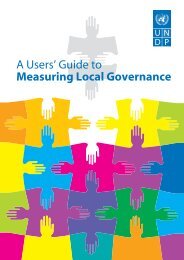planning a governance assessment - United Nations Development ...
planning a governance assessment - United Nations Development ...
planning a governance assessment - United Nations Development ...
Create successful ePaper yourself
Turn your PDF publications into a flip-book with our unique Google optimized e-Paper software.
technical aspects of conducting a <strong>governance</strong> <strong>assessment</strong>. Topics are discussed in simple language in the hope that readers<br />
without much research experience will be able to grasp the fundamentals.<br />
This guide attempts to answer the rather complex question: how can country-led <strong>governance</strong> <strong>assessment</strong>s be carried out<br />
with broad stakeholder participation at a reasonable cost, and at the same time produce meaningful results that can be used<br />
by civil society and governments alike? We hope to provide some useful ideas and information needed to answer this question.<br />
An increasing number of nationally-based organizations are giving greater priority to the need to assess democracy,<br />
<strong>governance</strong> and human rights as part of their country’s national development plans. For many years, bilateral and<br />
multilateral donors have conducted various types of <strong>assessment</strong>s in many countries around the world. Many of these<br />
<strong>assessment</strong> tools and frameworks have been designed to provide comparisons over time and across countries and regions.<br />
While these external <strong>assessment</strong>s provide a rich source of information, they do not often point to national-level institutions<br />
or institutional arrangements. They also often lack national ownership and stakeholder engagement in the <strong>assessment</strong><br />
process. Moreover, they tend to offer aggregate results that fail to capture complexities and nuances of <strong>governance</strong> issues,<br />
and often overlook the perceptions of <strong>governance</strong> issues that impact marginalized groups in society, such as the poor and<br />
women.<br />
For UNDP, the value of a nationally owned <strong>governance</strong> measurement system is that it serves as a critical accountability<br />
mechanism for local stakeholders, especially the citizens of a country and non-state actors. Nationally owned systems<br />
provide upward internal rather than external pressure for reform. They provide a catalyst for greater citizen engagement<br />
in democratic processes and may well lead to better <strong>governance</strong> at local and national levels if the <strong>assessment</strong> efforts<br />
themselves use solid research methodologies and practice democratic <strong>governance</strong>. In addition, they must be conducted in<br />
a professional manner if they are to be viewed as legitimate. The professionalism and objectivity of those participating must<br />
be beyond question or reproach. Moreover, these <strong>assessment</strong>s need to take issues such as gender, ethnicity and different<br />
political viewpoints into account.<br />
This paper is arranged in 12 sections, in a structure that allows readers to easily access the subjects in which they are most<br />
interested. Each section provides some basic information on the topic, as well as some guidance on the costs and benefits<br />
of various approaches.<br />
• Section 1 examines participation in country-led <strong>governance</strong> <strong>assessment</strong>s<br />
• Section 2 discusses who conducts <strong>governance</strong> <strong>assessment</strong>s<br />
• Section 3 covers funding and technical assistance<br />
• Section 4 examines types of <strong>governance</strong> <strong>assessment</strong>s<br />
• Section 5 discusses the types of data and data collection methods<br />
• Section 6 presents several approaches to defining <strong>governance</strong> and developing <strong>governance</strong> frameworks<br />
• Section 7 examines different types of indicators, and discusses using existing indicators vs. developing new ones<br />
• Section 8 compares the various sampling strategies available<br />
• Section 9 discusses the analysis and presentation of data<br />
• Section 10 provides advice on ways to communicate and disseminate the results<br />
• Section11 compares four country-led approaches, including the costs<br />
• Section 12 offers brief concluding remarks on the role of <strong>governance</strong> in the <strong>assessment</strong> process, as well as a review<br />
of the main points of this paper<br />
<br />
Planning a Governance Assessment: A Guide to Approaches, Costs and Benefits








![GuÃa del Usuario ] - Governance Assessment Portal](https://img.yumpu.com/44740603/1/190x253/gua-a-del-usuario-governance-assessment-portal.jpg?quality=85)







